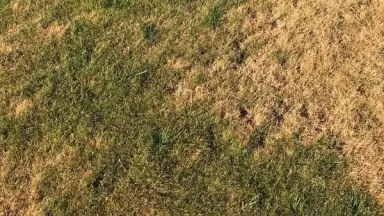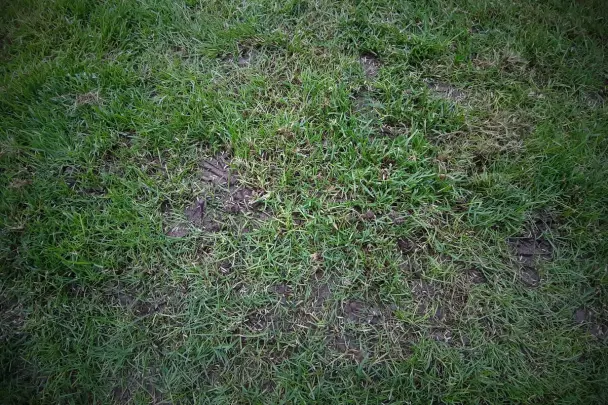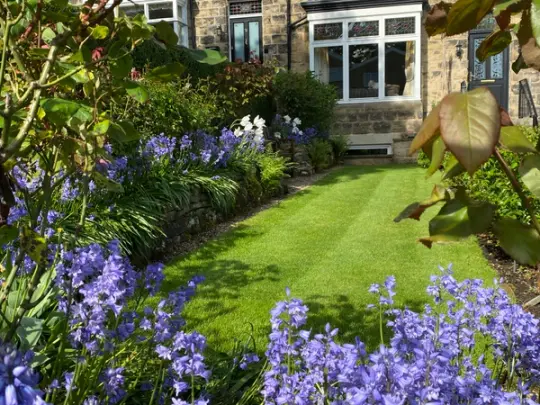Effective Lawn Care in Heat Waves and Warm Weather
As temperatures soar and heat waves become more frequent, giving your lawn the right care is more important than ever. Many lawns suffer during hot spells—turning yellow, thinning out, or going dormant—but with the right strategies, you can maintain a lush, resilient green lawn, even during the most extreme summer conditions.
In this guide, we’ll cover expert tips and practical lawn care techniques for hot weather, including how to adjust your mowing, irrigation, soil care, and more. Whether you’re facing a dry spell or a full-blown heat wave, this guide will help you protect your lawn and ensure grass recovery after heat stress.

Author
Leanne Lewis
Reviewed By
Alasdair Boyes
Updated: 12/9/2025
Published: 8/4/2025
Optimised Mowing Practices for High Temperatures
Mowing might seem like a routine task, but in high temperatures, it requires a thoughtful approach:

Raise the Mower Height: One of the easiest ways to protect your lawn during a heat wave is by cutting less. Set your mower blade higher than usual—taller grass shades the soil, keeps roots cooler, and slows evaporation.

Reduce Mowing Frequency: During prolonged heat and drought, your grass naturally grows more slowly. Resist the urge to mow too often, as cutting stressed grass can lead to long-term damage.

Keep Mower Blades Sharp: A clean cut is healthier for grass blades, especially in hot weather. Dull blades tear the grass, increasing vulnerability to heat stress and disease.
Maintaining slightly taller grass also promotes deeper root systems, which help your lawn find moisture further down in the soil—key to surviving periods without rain.
Watering Strategies for a Thriving Lawn
Proper hydration is vital to support your lawn through hot weather. Here’s how to water lawn in summer heat effectively:

Water Early or Late: The best time to water lawn in summer is early in the morning (before 10 a.m.) or in the evening, once the sun is low. This prevents excessive evaporation and ensures more moisture reaches the roots.

Deep, Infrequent Watering: Aim for one deep soak per week—about 1 to 1.5 inches of water—rather than frequent, shallow watering. Deep watering encourages roots to grow deeper, making your lawn more drought-tolerant.

Avoid Watering at Peak Heat: Midday watering is inefficient and may scorch the grass due to the sun's intensity.
Sustainable Tip:

Use Rainwater: Installing a rainwater harvesting system can help conserve resources while giving your lawn soft, chemical-free water. This environmentally friendly approach is particularly valuable during hosepipe bans or drought restrictions.

Signs of summer stress: dry, patchy lawn needs extra care
Shielding Your Lawn from Heat Stress
While watering and mowing adjustments are crucial, you can go further by physically protecting your lawn during heat waves.
How to Reduce Heat Stress:

Create Shade: Plant shade-giving trees or install garden features like pergolas and trellises. Not only do they beautify your garden, but they also reduce soil temperature in high-exposure areas.

Temporary Protection: Use shade cloths or sails to protect vulnerable areas of your lawn during extreme heat. These are especially helpful for newly seeded or overseeded areas.

Avoid Heavy Use: Limit traffic on your lawn during dry spells, as compacted or worn areas are more susceptible to damage.
Remember, grass stress is reversible with good care. Lawns may turn brown to conserve energy in hot, dry periods—but with the right support, they can bounce back quickly once temperatures moderate and rain returns.
Lawn Treatments for Heat Resilience
Professional lawn care treatments can significantly improve your lawn’s ability to endure and recover from heat. At GreenThumb, we offer targeted services designed for warm-weather resilience:
- Oasis Treatment – Our water conserver improves moisture retention in the root zone and reduces evaporation. It helps grass stay green longer with less watering.
- NutraBooster – A bio-stimulant that enhances nutrient uptake, improves recovery from stress, and promotes deeper, denser growth, even in hot conditions.
These treatments are ideal during extended dry periods or as a recovery boost after a heatwave.
What to Avoid During a Heatwave
Heat-stressed grass is more vulnerable to damage. Avoid these common mistakes:
- ❌ Avoid scarifying or aerating during extreme heat: These processes can stress the lawn further.
- ❌ Don't overwater: Saturated soil can still lead to root rot if it doesn’t drain well—especially in high humidity.
Recap: How to Look After Your Lawn in a Heatwave
- Raise mower blades and mow less frequently
- Water deeply and early in the day
- Use shade and reduce traffic to protect stressed areas
- Consider professional treatments like Oasis and NutraBooster
- Let the grass go dormant—brown grass isn’t dead; it’s just resting
Planning for Recovery After Heat Stress
Once cooler weather or rainfall returns, your lawn can recover—but it may need some support. This is a good time to:
- Apply a light fertiliser to encourage new growth
- Overseed thin patches with drought-tolerant grass seed
- Aerate compacted areas (once temperatures have dropped)
- Resume regular mowing and watering practices gradually
With these steps, you’ll not only look after your lawn in heat waves, but also strengthen it for long-term health—turning your garden into a green retreat, even in the hottest months
Help Your Lawn Beat the Heat – and Bounce Back After
Heatwaves can leave lawns dry, stressed, and patchy—but with the right care, recovery is possible. GreenThumb’s targeted treatments like Oasis and NutraBooster help protect your lawn during extreme heat and support healthy regrowth when temperatures cool.
Whether you're preparing for hot weather or helping your lawn recover, we're here to help it stay strong, green, and resilient.

Improves Water Efficiency
Oasis helps your lawn make the most of every drop by retaining moisture deep in the soil, keeping your grass nourished and hydrated for longer.
Read More
Lawn Problems
If you're noticing brown patches, weeds, or thinning grass, it’s important to identify the root cause. Lawn problems can stem from various factors, and understanding what’s affecting your grass is the first step toward a solution.
Read More
Lawn Refresh
Lawn Refresh is a six-step treatment designed to revive tired, patchy lawns through scarification, aeration, overseeding, and fertilisation. It’s an effective alternative to re-turfing, restoring your lawn’s health, density, and appearance.
Read More